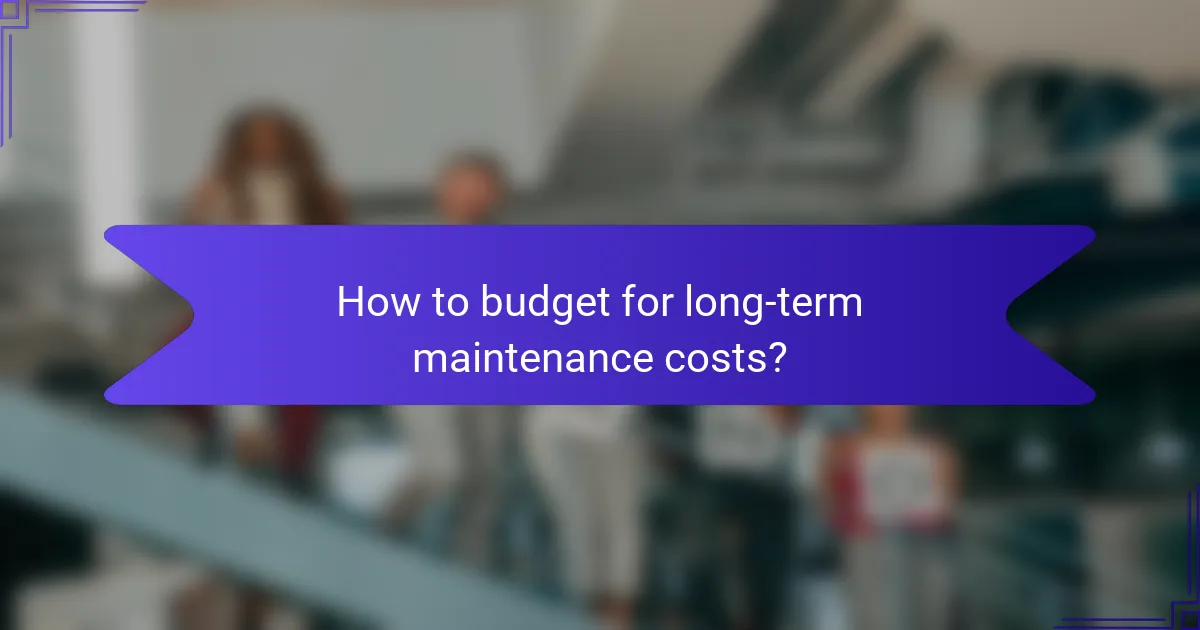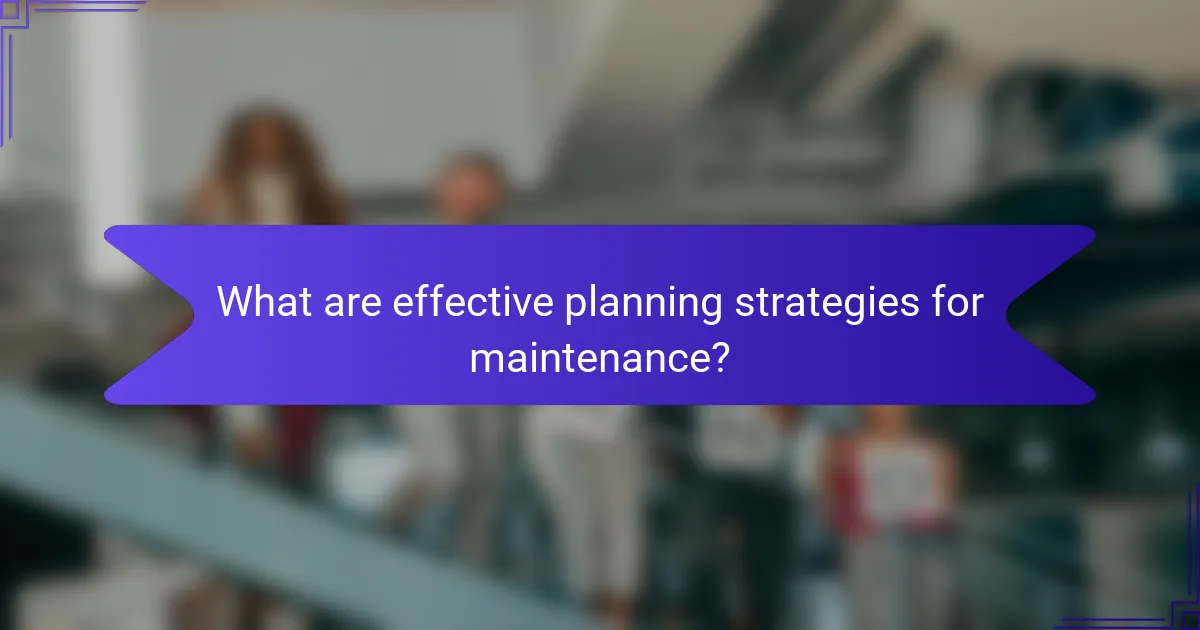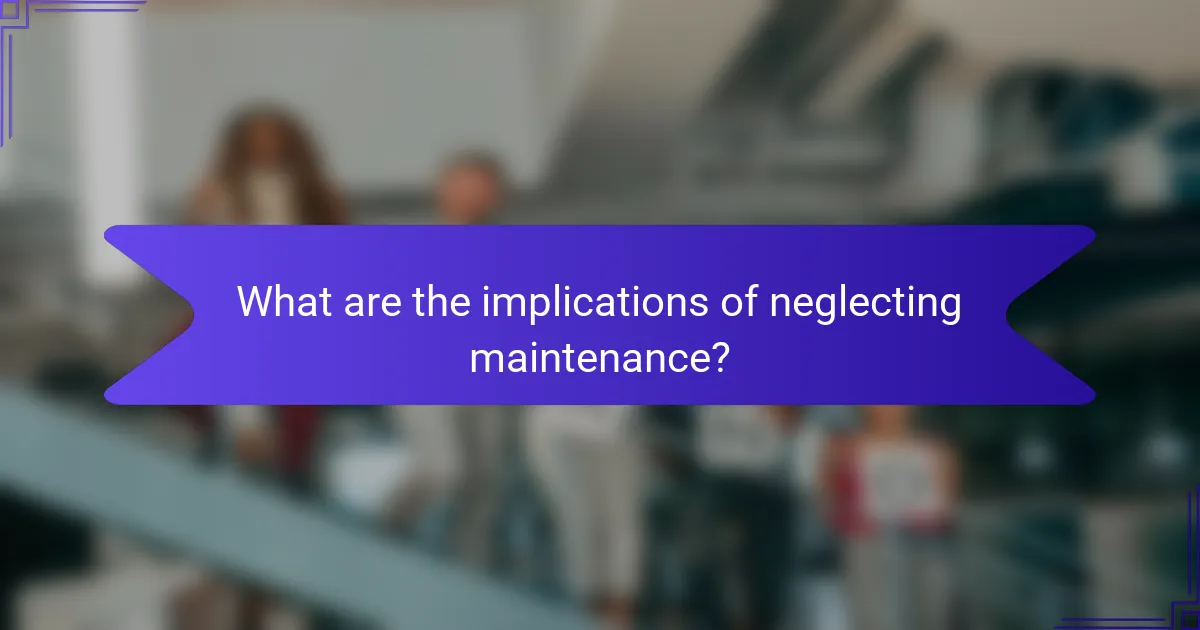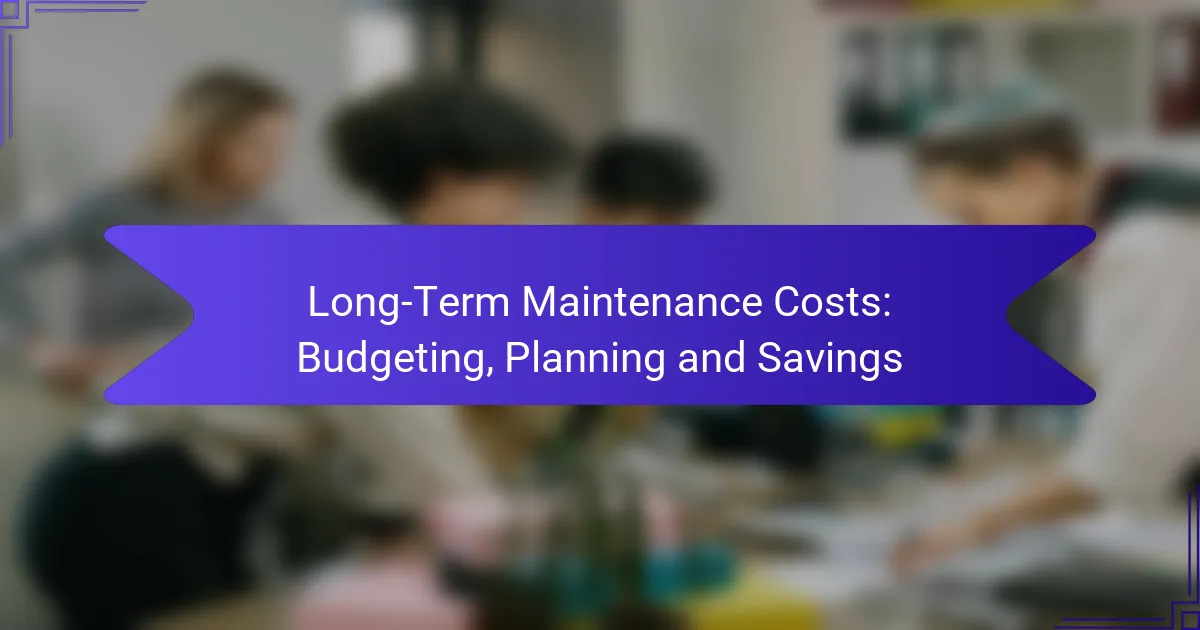Long-term maintenance costs are a crucial consideration for property owners and managers, as they can significantly impact overall budgeting. These expenses encompass regular upkeep, repairs, and unforeseen costs that accumulate over time. To effectively manage these costs, it’s vital to anticipate future expenses and implement strategic planning to ensure assets remain operational and efficient throughout their lifespan.

What are the long-term maintenance costs in South Africa?
Long-term maintenance costs in South Africa can vary significantly based on the type of property or asset. These costs typically include regular upkeep, repairs, and unexpected expenses, which can accumulate over time and impact overall budgeting.
Average annual maintenance costs
The average annual maintenance costs for residential properties in South Africa generally range from 1% to 3% of the property’s value. For example, a home valued at ZAR 1 million might incur maintenance expenses between ZAR 10,000 and ZAR 30,000 each year. This estimate can fluctuate based on property age, location, and condition.
Commercial properties often face higher maintenance costs, sometimes reaching 5% of the property’s value annually. This is due to more extensive facilities and systems that require regular servicing.
Factors influencing maintenance costs
Several factors can influence long-term maintenance costs, including property age, type of materials used in construction, and local climate conditions. Older properties may require more frequent repairs, while properties built with durable materials may incur lower costs over time.
Additionally, geographical location plays a significant role. Areas prone to extreme weather conditions, such as heavy rainfall or high temperatures, might see increased maintenance needs. Regular inspections and proactive maintenance can help mitigate some of these costs.
Lastly, the choice of service providers can impact expenses. It’s advisable to compare quotes and consider long-term relationships with reliable contractors to ensure quality work at reasonable prices.

How to budget for long-term maintenance costs?
To budget for long-term maintenance costs, it’s essential to anticipate future expenses related to property or equipment upkeep. This involves estimating costs based on previous spending, industry standards, and the specific needs of the asset over its lifespan.
Creating a maintenance budget
Start by assessing the current condition of your assets and identifying necessary maintenance tasks. Consider factors such as age, usage, and manufacturer recommendations to estimate costs accurately. A good rule of thumb is to allocate 1-3% of the asset’s value annually for maintenance.
Break down your budget into categories like routine maintenance, emergency repairs, and upgrades. This will help you prioritize spending and ensure you have funds available for unexpected issues. Regularly review and adjust your budget based on actual expenses and changing conditions.
Common budgeting mistakes
One common mistake is underestimating the costs associated with maintenance. Many people overlook factors like inflation, labor rates, and material costs, leading to budget shortfalls. Always factor in a contingency of around 10-20% to cover unforeseen expenses.
Another pitfall is failing to track actual spending against the budget. Without regular monitoring, it’s easy to lose sight of where funds are going, which can lead to overspending in certain areas. Implement a tracking system to compare your budgeted amounts with actual expenses to stay on course.

What are effective planning strategies for maintenance?
Effective planning strategies for maintenance involve anticipating future needs and scheduling tasks to minimize downtime and costs. By implementing structured approaches, organizations can ensure their assets remain operational and efficient over the long term.
Preventive maintenance planning
Preventive maintenance planning focuses on regularly scheduled inspections and servicing to prevent equipment failures. This strategy typically includes routine checks, cleaning, and part replacements based on manufacturers’ recommendations or industry best practices.
To implement effective preventive maintenance, create a checklist of tasks and establish a timeline for each. For instance, HVAC systems may require biannual inspections, while machinery might need monthly lubrication checks. This proactive approach can reduce unexpected breakdowns and extend the lifespan of assets.
Scheduling maintenance tasks
Scheduling maintenance tasks involves organizing and prioritizing maintenance activities to align with operational needs. This can be done using software tools that allow for tracking and reminders, ensuring that tasks are completed on time without disrupting production.
Consider using a calendar system to visualize maintenance schedules, allocating specific time slots for each task. For example, plan routine maintenance during off-peak hours to minimize impact on operations. Regularly review and adjust the schedule based on equipment performance and feedback from maintenance staff to optimize efficiency.

How can you save on long-term maintenance costs?
Saving on long-term maintenance costs involves strategic planning, adopting efficient practices, and leveraging technology. By being proactive and informed, you can significantly reduce expenses over time.
Cost-saving maintenance practices
Implementing regular maintenance schedules can help identify issues before they escalate into costly repairs. For example, routine inspections of HVAC systems and plumbing can prevent major failures that require expensive fixes.
Consider using high-quality materials that may have a higher upfront cost but offer greater durability and lower maintenance needs in the long run. This approach can lead to savings on repairs and replacements over time.
Additionally, training staff or family members on basic maintenance tasks can save on labor costs. Simple tasks like changing air filters or cleaning gutters can be done in-house, reducing the need for professional services.
Utilizing technology for savings
Technology can play a crucial role in reducing long-term maintenance expenses. For instance, using smart home devices can help monitor systems and alert you to potential issues before they become serious problems.
Investing in maintenance management software can streamline scheduling and tracking of maintenance tasks, ensuring nothing is overlooked. This can lead to more efficient use of resources and reduced downtime.
Consider adopting predictive maintenance technologies that analyze data to forecast when maintenance should be performed. This approach can minimize unexpected failures and extend the lifespan of your assets, ultimately leading to significant cost savings.

What are the best tools for maintenance budgeting?
The best tools for maintenance budgeting include software solutions that help track expenses, forecast future costs, and manage resources efficiently. These tools can streamline the budgeting process, making it easier to allocate funds and plan for long-term maintenance needs.
Software solutions for budgeting
Popular software solutions for maintenance budgeting include programs like QuickBooks, Microsoft Excel, and specialized maintenance management systems like CMMS (Computerized Maintenance Management Systems). These tools allow users to input data on past expenditures, predict future costs, and generate reports to visualize spending trends.
When selecting software, consider factors such as ease of use, integration with existing systems, and the ability to customize reports. Many solutions offer cloud-based options, which can enhance accessibility and collaboration among team members.
Comparison of budgeting tools
When comparing budgeting tools, consider their features, pricing, and user reviews. For instance, QuickBooks is well-known for its comprehensive accounting capabilities but may require additional training for new users. On the other hand, Excel offers flexibility and familiarity but lacks specialized maintenance tracking features.
Another option is CMMS software, which often includes modules specifically designed for maintenance budgeting. While these tools can be more expensive, they provide tailored functionalities that can save time and reduce errors in the budgeting process. Evaluate your organization’s specific needs to determine the best fit.

How does maintenance vary by property type in South Africa?
Maintenance costs in South Africa differ significantly based on property type, affecting budgeting and planning. Residential properties typically incur lower costs compared to commercial properties, which often require more extensive upkeep due to their size and usage demands.
Residential vs commercial maintenance costs
Residential maintenance costs generally range from 1% to 3% of the property’s value annually. This includes routine tasks like plumbing repairs, electrical work, and landscaping. In contrast, commercial properties can face maintenance expenses that are 2 to 4 times higher, driven by more complex systems and the need for compliance with stricter regulations.
For example, a residential property valued at ZAR 1 million may incur ZAR 10,000 to ZAR 30,000 in maintenance each year, while a commercial property of the same value could see costs between ZAR 20,000 and ZAR 40,000. Property owners should factor in these differences when budgeting.
Maintenance for different building materials
The choice of building materials significantly influences maintenance requirements and costs. For instance, brick and concrete structures typically demand less upkeep compared to wood, which may require regular treatments and inspections for pests and rot.
Metal roofs, while durable, can necessitate periodic painting and rust prevention, adding to long-term costs. Homeowners and property managers should assess the material used in their buildings and plan for specific maintenance needs, ensuring they allocate sufficient funds for upkeep.

What are the implications of neglecting maintenance?
Neglecting maintenance can lead to significant long-term costs and operational issues. Failing to address routine upkeep may result in equipment breakdowns, safety hazards, and compliance violations.
Long-term financial impacts
Ignoring maintenance can escalate repair costs over time, often leading to expenses that are several times higher than regular upkeep. For instance, a minor issue left unaddressed can develop into a major failure, requiring costly replacements or extensive repairs.
Additionally, businesses may face increased operational costs due to inefficiencies and downtime. Budgeting for maintenance is essential; setting aside around 1-3% of total asset value annually is a common guideline to ensure funds are available for necessary repairs.
Safety and compliance risks
Neglecting maintenance can create serious safety hazards, putting employees and customers at risk. For example, malfunctioning equipment can lead to accidents, injuries, or even fatalities, which can have devastating consequences for a business.
Moreover, failing to maintain equipment can result in non-compliance with industry regulations, leading to fines or legal action. Regular inspections and maintenance help ensure that all equipment meets safety standards, protecting both the workforce and the organization’s reputation.

What emerging trends affect maintenance costs?
Emerging trends significantly influence long-term maintenance costs by shifting priorities towards sustainability and leveraging technological advancements. Understanding these trends helps organizations budget effectively and plan for future expenses.
Impact of sustainability on costs
Sustainability initiatives often lead to increased upfront costs but can result in lower long-term maintenance expenses. For instance, investing in energy-efficient systems may require higher initial capital but can reduce utility bills and maintenance needs over time.
Organizations should consider the lifecycle costs of sustainable options, which often include savings from reduced resource consumption and potential tax incentives. Evaluating the total cost of ownership (TCO) can provide a clearer picture of the financial benefits of sustainable practices.
Technological advancements in maintenance
Technological advancements, such as predictive maintenance and IoT (Internet of Things) applications, are transforming how organizations manage maintenance costs. These technologies enable real-time monitoring and data analysis, allowing for proactive maintenance that can prevent costly breakdowns.
Investing in technology can lead to significant savings by optimizing maintenance schedules and reducing downtime. However, organizations must weigh the initial investment against potential long-term savings to determine the best approach for their specific needs.
